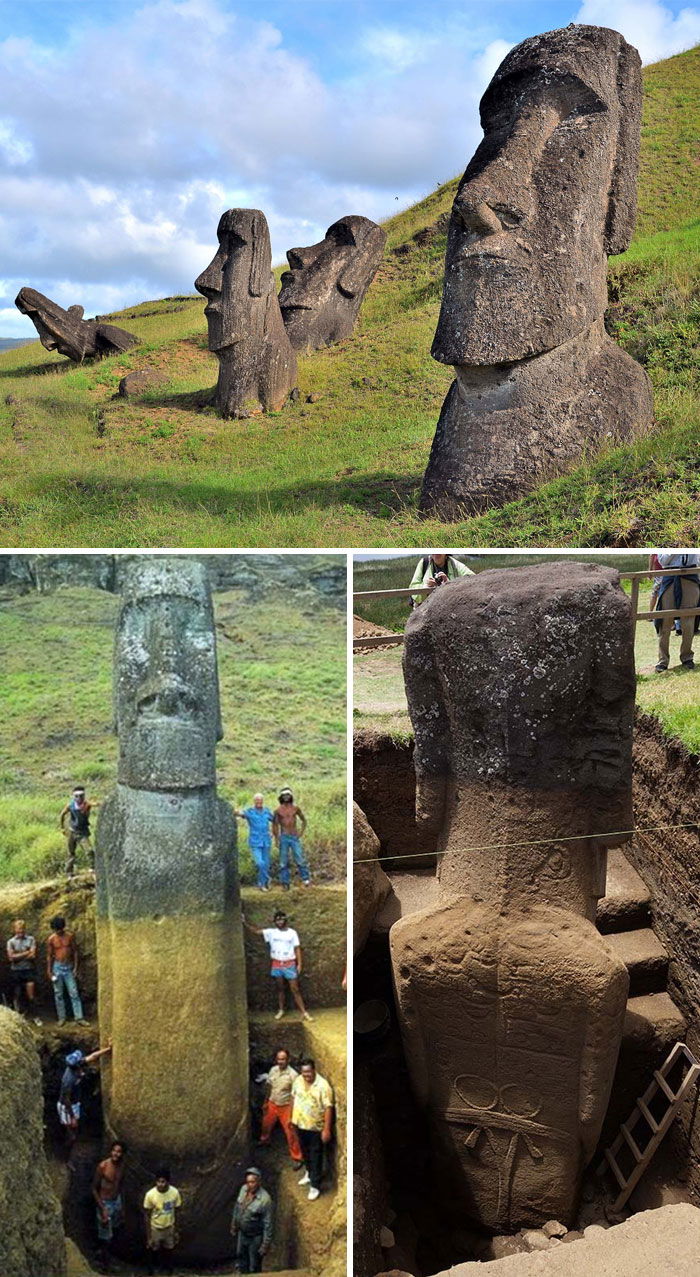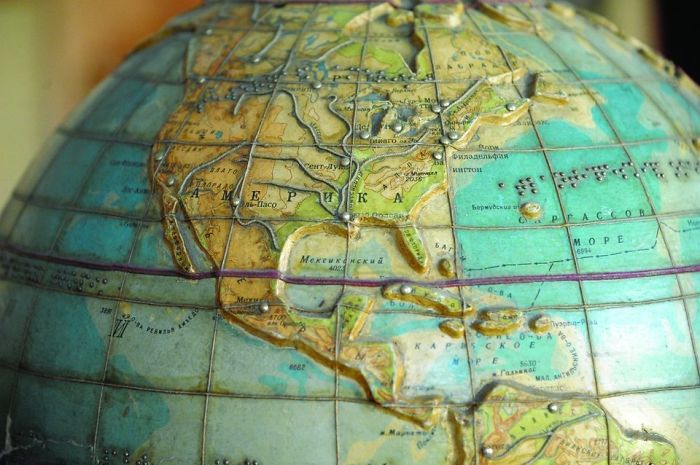Getting caught up in our daily, furious lives makes us not see all the beautiful surroundings. We almost forgot to breathe fresh air, face the sun, or smell those beautiful flowers in the corner up there.
Viral Strange will present 30 pictures of objects or things we know or have looked at in our everyday life. In this article, we’ll reveal the unseen side of those things.
1. A Cleaned Up Heart

This is what a cleaned heart looks like. By washing away all donor cells, it’s left with a protein scaffold – ready for a transplant to a new ‘home’.
2. The “Easter Island Heads” Have Bodies

Most people know them as ‘Easter Island Heads’, but their traditional name is “Moai” – that’s why people feel shocked when they discover they have bodies. The ‘Easter Island Heads’ were craved by ancient Polynesians between A.D 1100 and 1500.
3. Wondering How A Baby Flamingo Looks Like?

This baby flamingo is missing his pink color. That’s why it doesn’t look like one. As these fluffy species grow up, they develop their pink feathers.
4. An Intact Human Nervous System

This is the human nervous system intact. It was dissected by two medical students in 1925 in Missouri. There are only 4 of these in the world.
This one is located at the Museum of Osteopathic Medicine at A.T. Still University (ATSU) in Kirksville.
5. How Does Salt Look Under Electron Microscope?

We already know that salt crystals are cubic (We do, don’t we?). However, some grains are made up of overlapping cubes. This happens because of the ionic compound (sodium and chloride molecules) that often arranges itself.
6. Ice Crystals In Switzerland

As you can also see in the picture above: “In the absence of supercooled liquid water, the growth of ice crystals to precipitation size is most likely dominated by aggregation of smaller ice crystals, which depends on the ice crystal number concentration and temperature (Hobbs et al. 1974).”
7. Aurora Of Different Planets

Aurora’s are cosmic light displays that happen to be seen on different planets. The Sun emits solar winds into the solar systems. When they reach other planets’ magnetic fields, it creates a collision of nitrogen and oxygen in the atmosphere. This collision gives off energy in the form of colored lights.
8. A Tiger’s Shaved Skin

The skin of the tiger is also striped beneath the patterned fur.
“The darkness of the pigmentation of the skin seems to be directly related to the darkness of the fur.”, says Tigers.org.
9. Glass Frog

Found in the rain forests of Costa Rica, Panama, Colombia, and Ecuador, the transparent skin f these frogs allows us to see every internal organ.
10. The New “Home” Of An Agate Shell

Agate shells are found on West Coast beaches. Even though they’re not that rare, they are a real beauty!
11. A Globe For Blind People!

Samuel Gridley Howe created a method of embossing maps. In 1837, he released the Atlas of the United States Printed for Use of the Blind.
12. An Albino Racoon

Have you ever seen an albino raccoon? Their lifespan is shorter. That’s because of their lack of camouflage which makes predators catch their prey easier.
13. The “Dark Side” Of The Moon

This image taken from NASA at DSCOVR shows a clear “dark side” of the Moon that’s not visible from Earth.
14. Some 5-Pointed Starfish Can Be Squared Due To Birth Defects

There are about 1500 species of starfish. Some species live from tropical to frigid polar waters or from the intertidal zone to abyssal depths.
15. Thousands Of Years In One Photo

Dún Briste (the Broken Fort) is considered a new sea stack. It was separated from mainland Ireland in 1393 when monster seas severed it from County Mayo. It’s approximately 50 meters long and 15 meters across the center. In 1980 three scientists discovered the remains of a building. It showed details to assume that both people and livestock lived together inside it.
16. Snow Covered Net Roof Of The Aviary In The Zoo

The largest walk-through aviary was built in 1904 by the Smithsonian Insitute and was bought by the Saint Louis Zoo, where it remains to this day.
17. Microbes Left Behind From The Handprint Of An 8-Year-Old Boy After Playing Outside

Most of the germs are harmless. Growing up in a “natural” environment help kids develop a better immune system.
18. Giant Amethyst Geode

Geodes are rocks that contain amethyst crystals. According to the Guinness Book of World Records, the largest amethyst geode weighs 13000 kg, displayed in Shandong Tianyu Museum of Natural History in Shandong, China.
19. What’s Under A Reporter’s Back

This is what’s placed under a reporter’s back. This is a receiver for her in-ear piece, which allows the reporter to hear the team in the back.
20. An Actual Virus Via Electron Microscope

This virus is part of the family of phages for short. Phages were seen under an electron microscope for the first time in 1940. This virus infects bacteria and cannot survive or reproduce without it.
21. An Empty Boeing 787

The Boeing 787 is known as the Dreamliner. The Dreamliner has been a commercial success. Alongside many problems occurring, its battery design was revised, and it was back in working mode within a few weeks.
22. This Is What An Elephant’s Tail Looks Like Up Close

Elephants can use their tails to communicate with each other and not only. It also works as a flyswatter to help keep away those annoying and biting flies.
23. A Salt Mine From The Inside

In Roman times, having salt on the table was a sign of wealth – that’s where the word ‘salary’ comes from.
24. The Inside Of A Space Suit

Facts about spacesuits, according to NASA:
- A spacesuit weighs approximately 280 pounds on the ground. In the microgravity environment of space, a spacesuit weighs nothing.
- Putting on a spacesuit takes 45 minutes, including the time it takes to put on the special undergarments that help keep astronauts cool. After putting on the spacesuit, to adapt to the lower pressure maintained in the suit, the astronaut must spend a little more than an hour breathing pure oxygen before going outside the pressurized module.
- The reason that spacesuits are white, is because white reflects heat in space the same as it does here on Earth. Temperatures in direct sunlight in space can be more than 275 degrees Fahrenheit.
No difference exists in a male’s or female’s suit, though the female astronaut usually requires a smaller size. - The shuttle spacesuit was designed to be made of many interchangeable parts, to accommodate a large number of astronauts with widely varying body sizes. These parts (upper and lower torsos, arms, etc.) are made in different sizes.
- The body measurements of each shuttle astronaut are taken and recorded. Then the measurements are plotted against the size ranges available for each spacesuit component. The suit components are then assembled. Training suits are usually assembled nine months before the flight, and flight suits are usually assembled four months before the flight.
25. What An Eclipse Looks Like From Space

This picture is taken by the former crew of Mir space station. They have estimated that the shadow passed through Earth at 2000 km per hour.
26. ‘Baby Driver’ Behind The Scenes

In Baby Driver, the red Subaru WRX becomes the star of the show, alongside a good performance of the actors. The real driver is on the top of the car, though.
27. A Dead Cactus Decomposed

The owner says that this cactus was wild, and its spines were very sharp!
28. Sperm Whales (The Largest Toothed Predators On Earth)

Sperm whales have 20-26 pairs of cone-shaped teeth along their lower jaw, but interestingly enough, none on the top – even though they don’t need teeth at all for surviving.
29. Strawberry’s Surface

This picture was taken from the photographer, Alexey Kljatov, who wrote on Flickr: “Focus stacking + averaging (10 groups with a different focus, each group contains 8 identical shots for averaging). The problem with this shot was that strawberry is too glossy (I put a white plastic bag around berry to diffuse daylight).”
30. A Fossilized Dinosaur Foot Print


Great article. Thanks